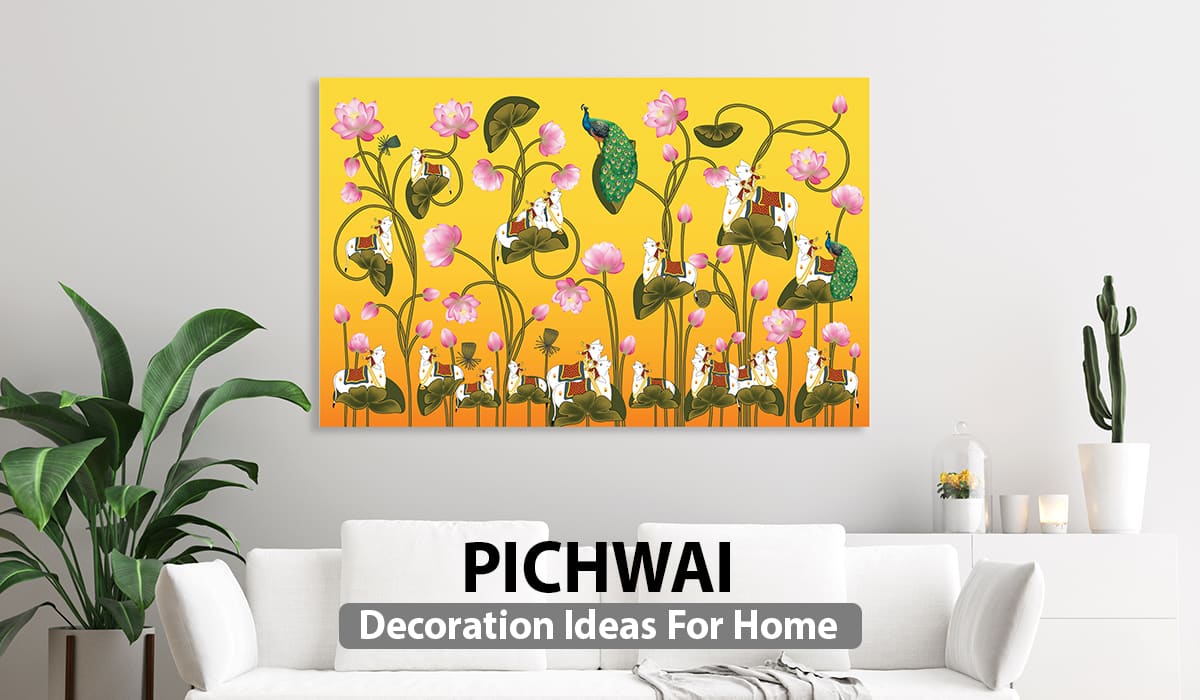India is home to a rich art tradition, and there are many schools and forms of art. The Pichwai art is unique and always in demand. Do you know what is a Pichwai painting?
Today, let us learn about this beautiful style of painting. Pichwai painting designs always add a touch of indian traditional elegance to any room- So if you want to bring some positive energy into your home, try some Pichwai art from Wall Curry.
Pichwai art history: A brief look
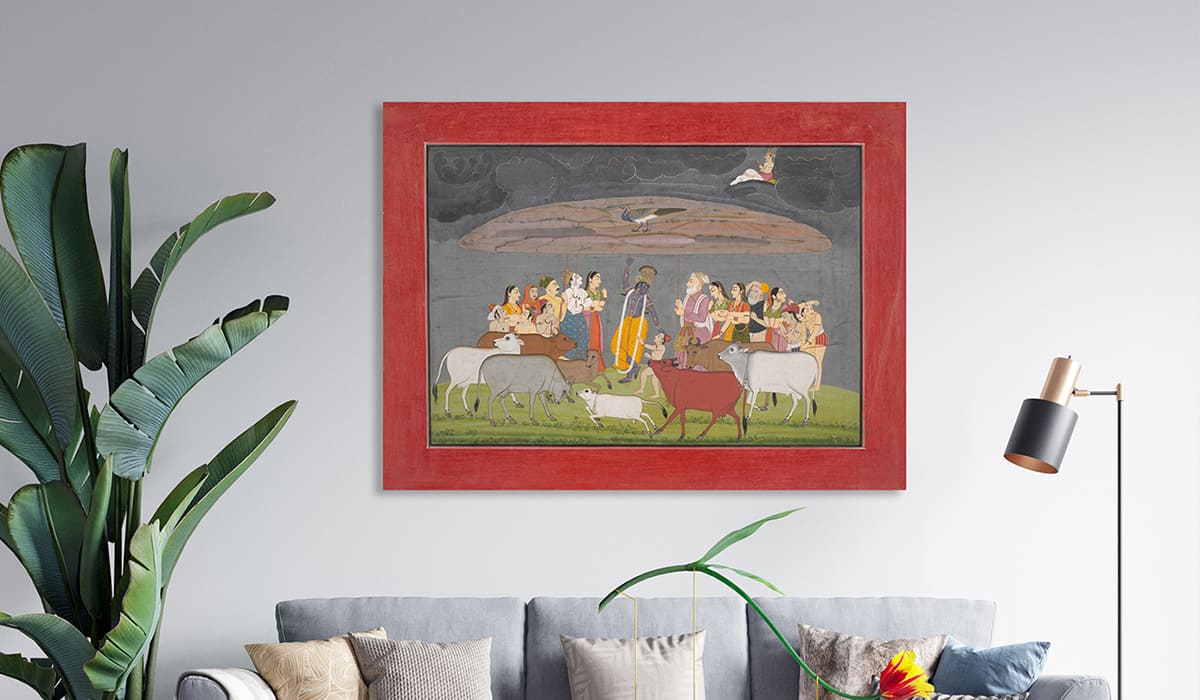
The Pichwai painting art was popular among the ancient Indians and afterward the Mughals. It was reintroduced in the 16th century and is now practiced in India and worldwide.
The word Pichhwai originates from the Sanskrit words “pichh,” which defines the “back,” and “wais” describes the “hanging.” Most Pichwai paintings depict the life story of Shrinathji, the form of Lord Krishna holding the Govardhan hill.
The majority of the Pichwai Paintings depict Lord Krishna’s boyhood adventures, with elements like Gopikas, cows, and calves, and show Lord Krishna playing the flute. The murals are painted on cloth, with the focal point being Lord Krishna.
Contemporary and easy pichwai painting have rich artistic heritage and value. They are often found hanging in art galleries. Also on the walls of the homes of art enthusiasts who respect traditional Indian handicrafts.
What is Pichwai Painting?
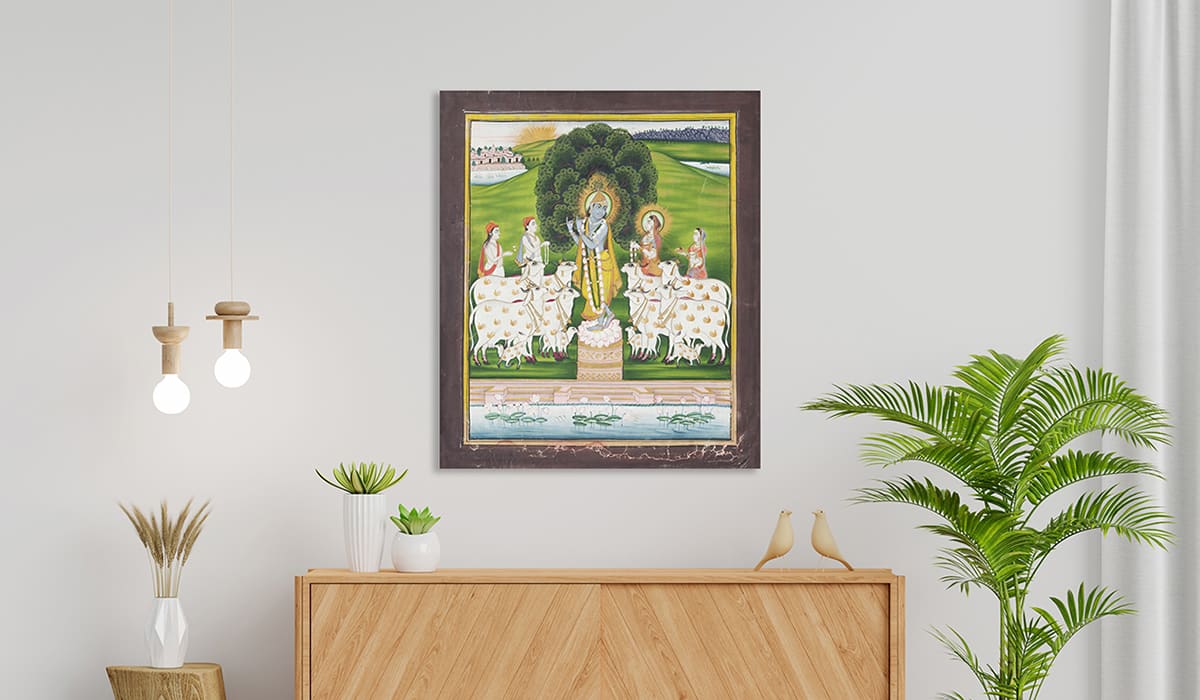
Pichwai is also known as the Pichwai, one of the most spectacular and ancient forms of Indian art. Pichwai paintings have their origins in the Rajasthani town of Nathdwara near Udaipur.
The exquisite 400-year-old art form depicts Lord Krishna’s glorious life. The narrative of Shrinathji, the incarnation of Lord Krishna clutching the hill Govardhan, is shown in them. Lord Krishna raised the mountain named Govardhan on his little pinky finger.
The people of Vrindavan took refuge beneath the mountain when Lord Indra demonstrated his authority over the inhabitants of Vrindavan with constant rains and thunderstorms. Indra’s ego was shattered when he discovered he had failed to disrupt their lives. Since then, people have been worshiping Govardhan hill and performing the Govardhan Pooja.
The Holy City of Nathdwara and the Pichwai painting history
Nathdwara city is one of the famous cities known for the temple of Krishna. It’s a city in the western state of Rajasthan, India. Nathdwara is located on the Aravalli Hills onthe banks of the Banas River, in Rajsamand District- 48 kilometers north-east of Udaipur. It has a significant Vaishnavite shrine for the Pushti marg sect.
To protect Lord Krishna’s idol from Mughal ruler Aurangzeb, the devotees transported it from Vrindavan to the village of Sinhad. When it reached the Sinhad, the bullock cartwheels sank deep in mud. And the pilot could not move it further.
The priests knew it was the Lord’s choice of location. As a result, a temple was constructed there during the reign of Maharana Raj Singh of Mewar.
What are the Materials used for Pichwai Painting Today?
An old Pichwai painting takes a long time to complete, from a few weeks to many months. Painters first draw this traditional art on hand-spun starched cloth and then paint or print the image in dazzling colors with hand blocks. And then a border embellished with gold, dabka work, or Swarovski crystals is created in modern iterations.
Traditional Indian pichwai painting used natural colors and even natural brushes. The foundation is primarily red, with yellow or other brightly colored embroidery. The emphasis is on employing vivid and vibrant colors like red, yellow, green, and black. And then a border in gold was created.
Pichwai Painting On Canvas
Pichwai art is a beautiful art form from Nathdwara, Rajasthan. It’s all about telling the story of Lord Krishna’s fantastic life, especially his extraordinary meeting with Govardhan Hill. These beautiful paintings depict Lord Krishna’s childhood adventures with Gopikas, cows, and calves.
Artisans carefully craft these paintings on hand-spun starched cloth, showcasing meticulous attention to detail and vibrant, eye-catching colors while portraying the central figure, Lord Krishna. Traditional Pichwai artists use colors from plants and minerals, showing their dedication to keeping things authentic. Creating this art form takes a lot of patience and precision.
Over several days, artisans meticulously prepare the cloth, utilizing pigments sourced from nature. Crafted from goat and squirrel hairs, the brushes enable artists to create fine lines and intricate details.
Bring the heavenly energy and intricate artistry of Pichwai paintings—a tribute to the enduring legacy of Indian art—into your living space. Discover the exquisite allure of Pichwai’s paintings on canvas in WallCurry’s carefully selected collection.
Drawing the Pichwai Painting: What is Pichwai Painting Technique?
The beginner easy pichwai painting technique involves applying the pigments after heavily starching the fabric. It is usually a thick woven cotton cloth. Then, painters use binders and adhesives to apply the colors on the exterior. These paintings were traditionally delineated on a black or white surface.
The pigments are derived from plant and mineral materials such as indigo, copper acetate, mercury sulfide, lapis lazuli, and lamp black. The painting brushes were of goat hair and squirrel hairs for more delicate lines.
What are Different types of Pichwai Paintings?
Here are some popular forms of Pichwai paintings:
1. What is Lotus pichwai painting
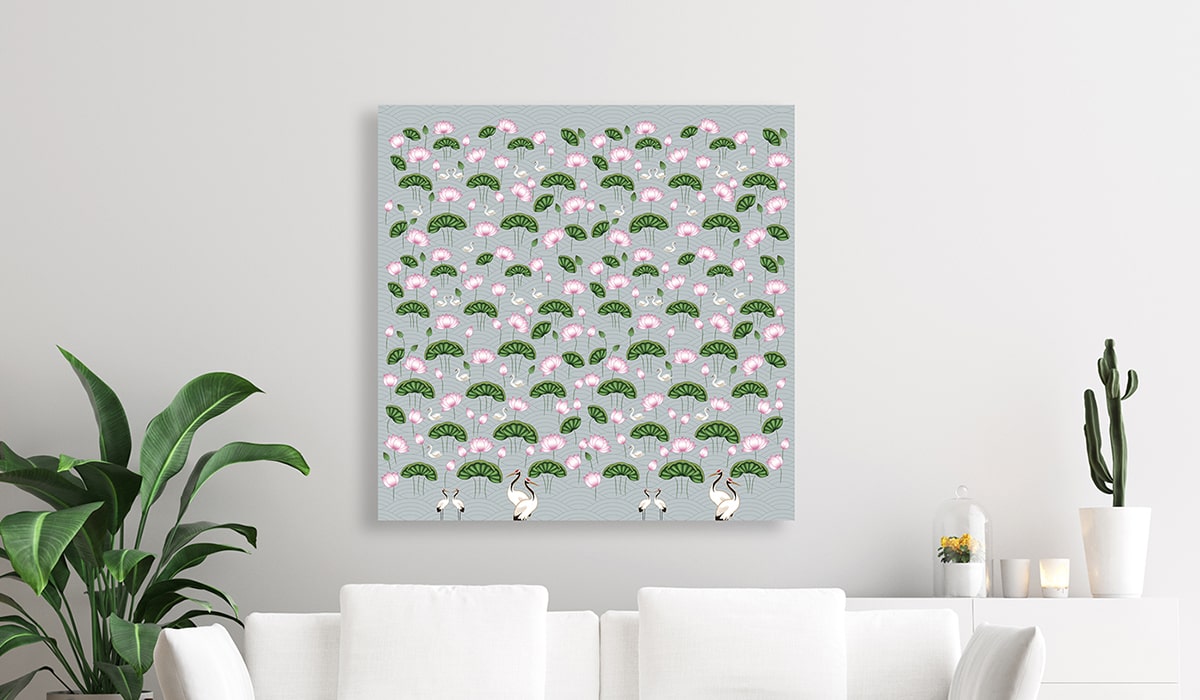
Pichwai lotus painting depicts the Lord in different Leelas with the moon, lotus blooms, peacocks, parrots, or cows. The scenery is of the lush vegetation the original artists saw aplenty in their surroundings. The lotus flower and pichwai paintings are synonymous with each other as lotus is the favorite flower of Srinathji or Krishan ji . Paintings in this vein are also known as the Shrinathji Pichwai Art.
Lord Krishna loved the lotus flower as Srinathji. Many paintings depict Lord Krishna as holding one lotus in his right hand and wearing a Garland of lotuses. Also, lotus flowers often decorate his bed.
2. Cow pichwai painting
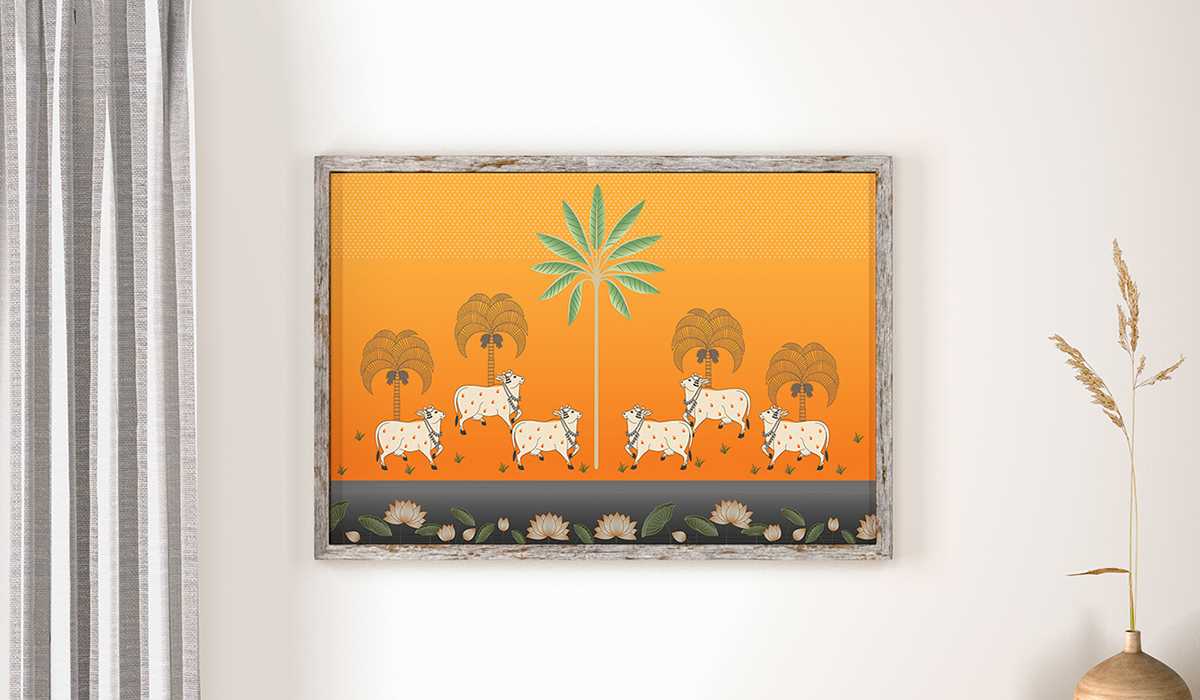
Cows are an essential part of Hindu mythology. And also play a significant role in the story of Krishna. Therefore, they form an integral part of many Pichwai Paintings.
3. Sharad Purnima Antique Pichwai painting
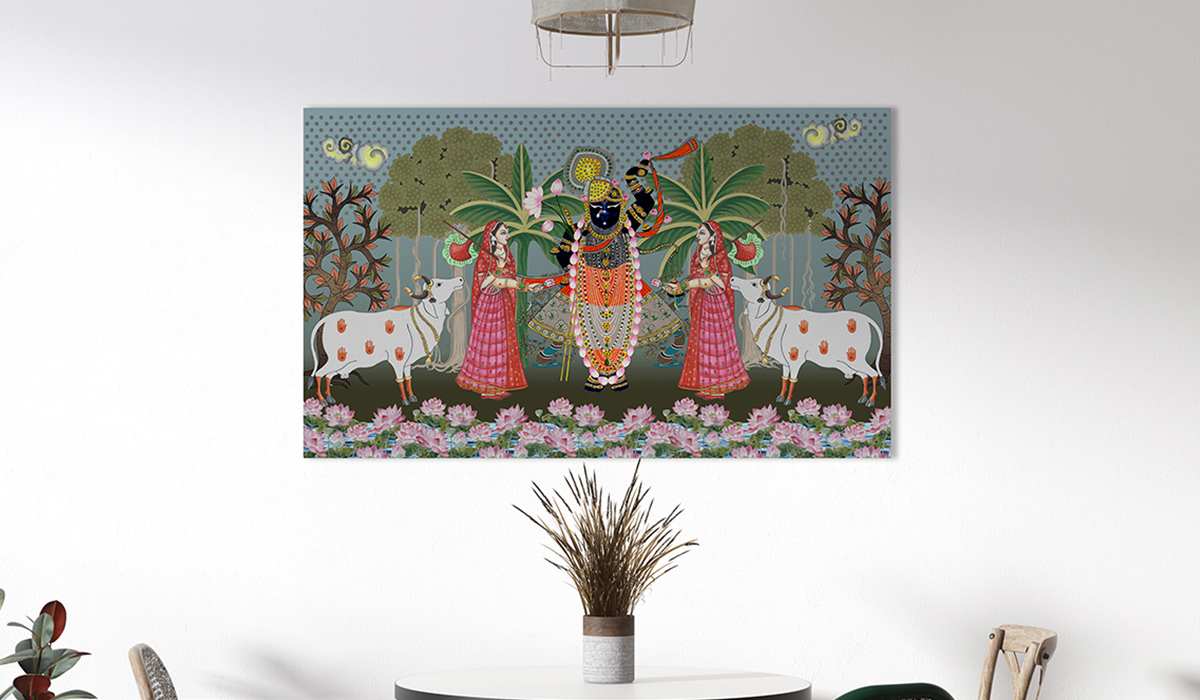
Among the different types of Pichwai arts, a significant theme is the celebration of the autumn festival of Sharad Purnima. The swing ceremony of Radha and Krishna on the night of the full moon.
4. Gold tree of life
The tree of life is a significant and wide spread theme or archetype in many of the world’s mythologies, religious, traditional, and philosophical traditions. Therefore, it is closely related to the concept of the sacred tree.
5. Peacock pichwai painting
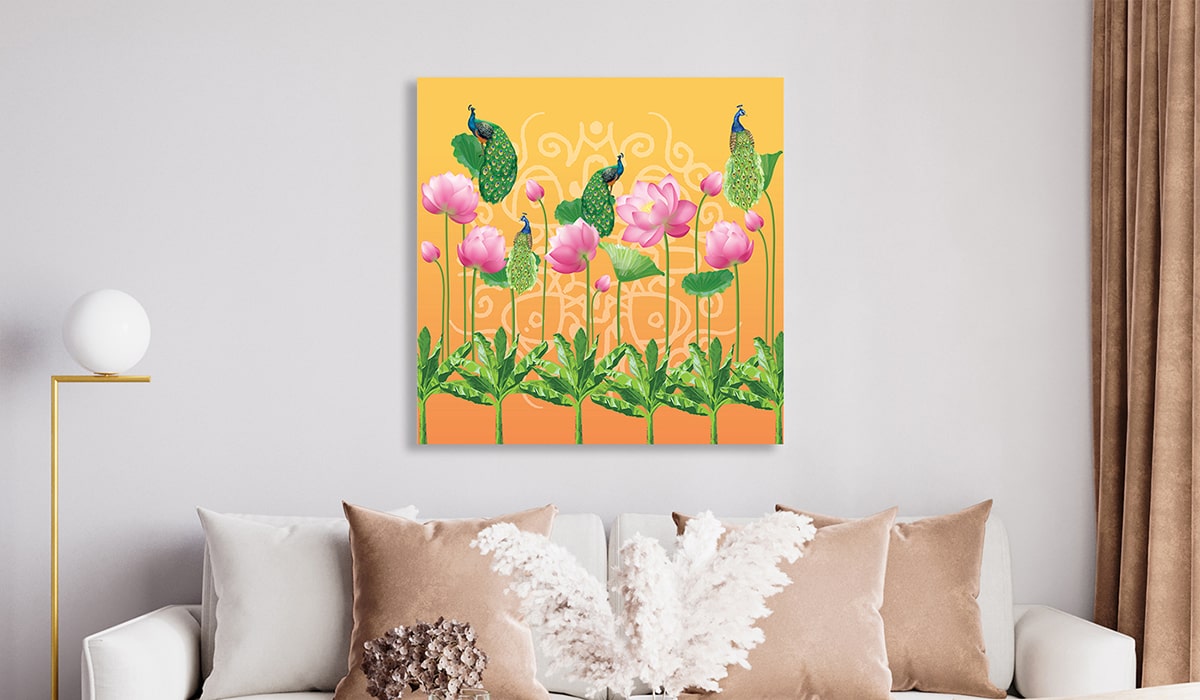
Peacock pichwai paintings usually show Shrinath Ji in the center, wearing rich clothes with a peacock feather on his crown, surrounded with peacocks. Shrinath Ji is shown in a cradle depicting the Janmasthami festival, with celebrations unfolding around him and people eagerly awaiting a look.
6. Sandhya aarti pichwai
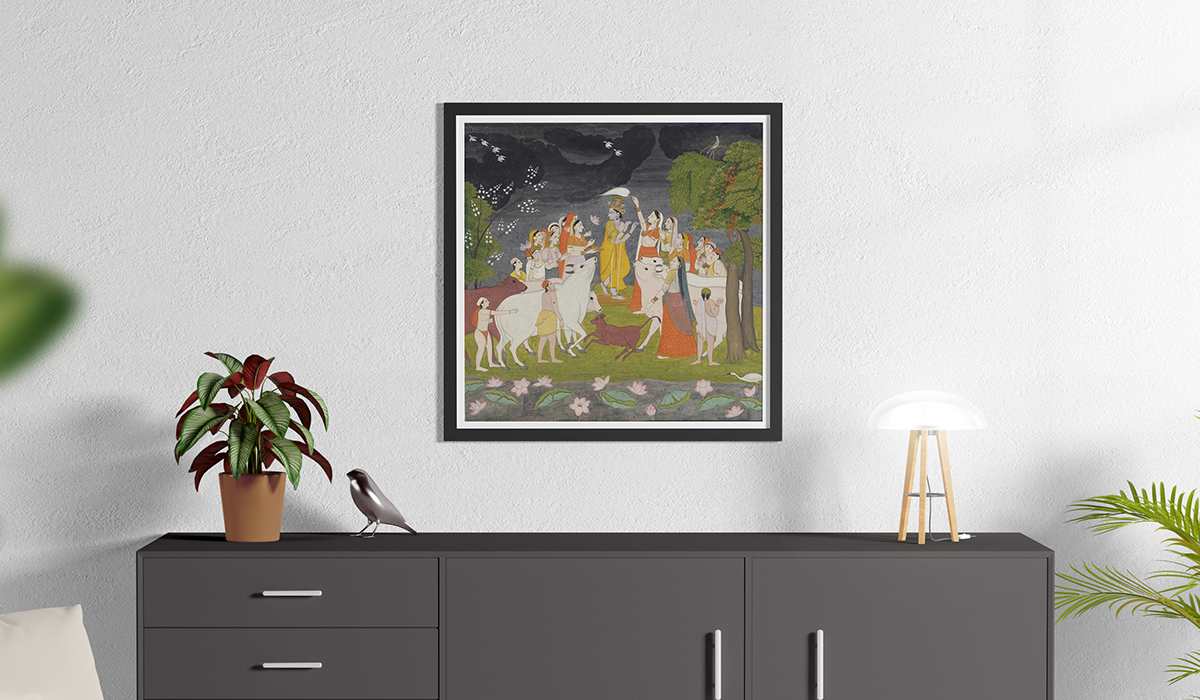
The Sandhya aarti pichwai is an ancient composition depicting Yashoda and the gopis greeting Krishna, Balarama, and their gopa friends as they return home from grazing with their herd.
7. What is pichwai painting of Radha Krishna
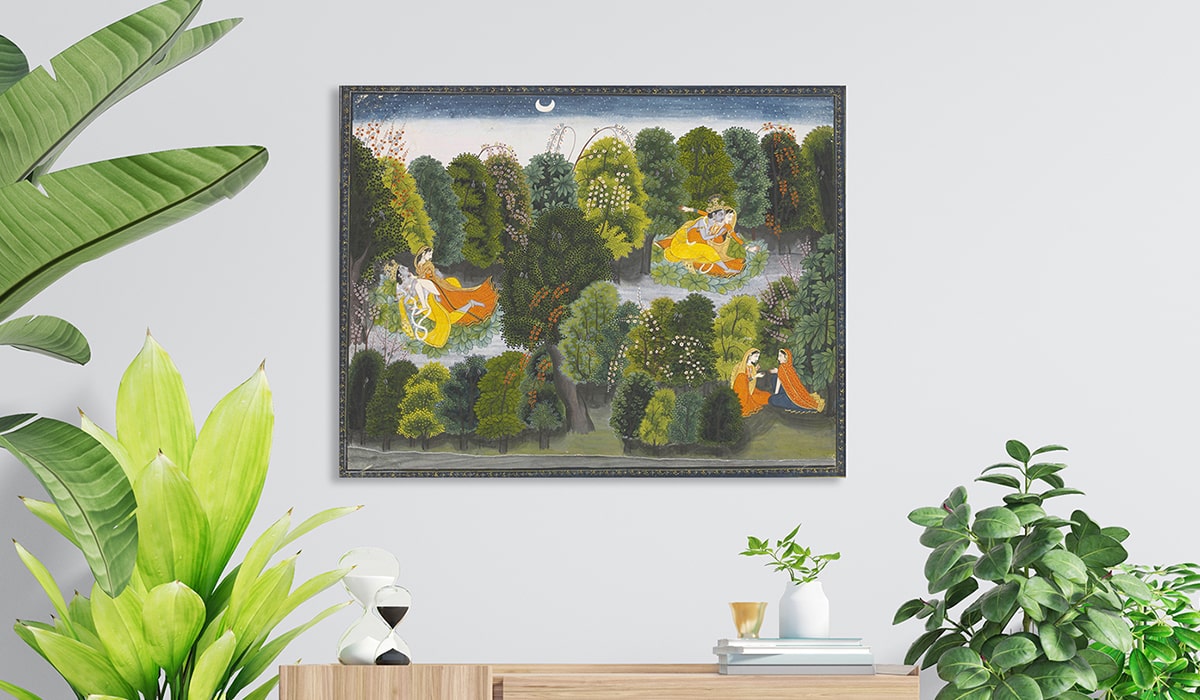
Rasaleela is the most famous representation of Radha and Krishna’s love story. It depicts Krishna playing his flute and Radha listening to him. In these paintings you can also see the Gopis dancing around them. You can order Radha Krishna painting on canvas from Wall Curry.
What is Pichwai Painting in the worship of Lord Krishna’s Significance?
The devotees belonging to the Pushti Marg observe 24 essential darshans and festivals. At the time of formal viewing, the offering includes the sumptuous food defined as bhoga and divine adornment, Shringara. Here pichwais play a significant role as part of a matched set of textile coverings, including wall coverings, ceiling canopies, and coverings for the throne, steps, and other platforms.
Shrinathji Pichwai Paintings- religious and cultural themes represented
1. Annakoot
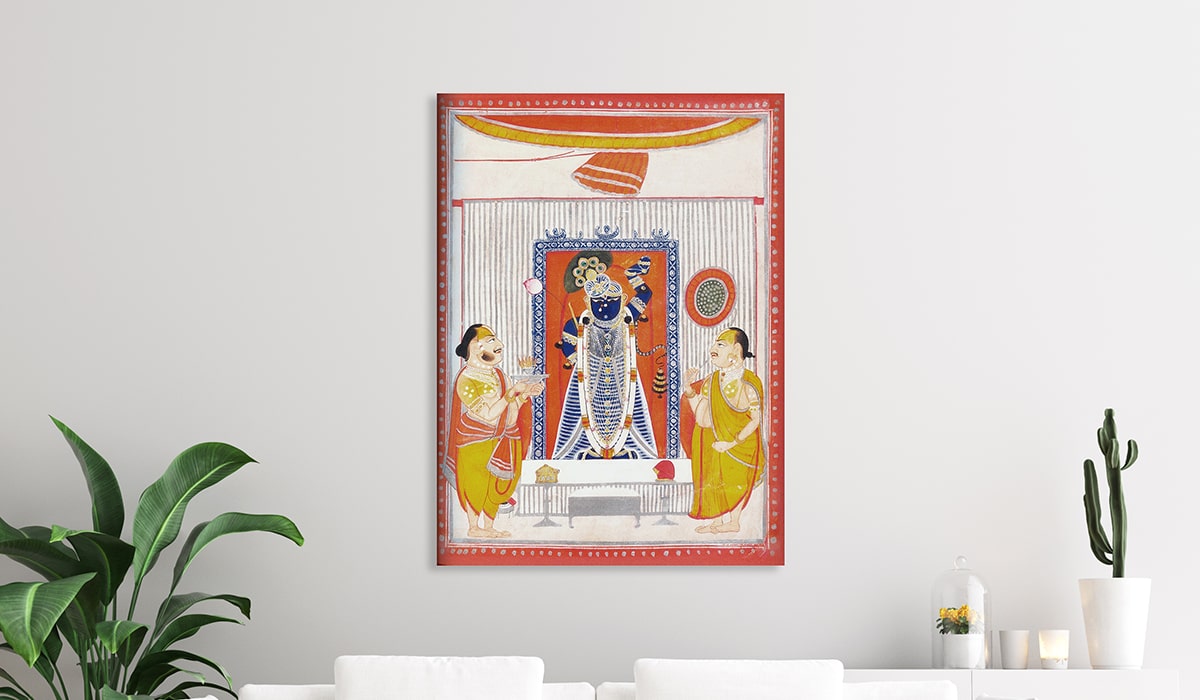
Annakoot implies the Govardhan Pooja. It depicts Krishna with his left arm raised above his head, depicting how he lifted the mountain. Worshippers place their offerings in front of the statue, signifying the offerings that Krishna requested the locals to make to Mount Govardhan rather than Indra.
Indra, who had no idea who Krishna was, became enraged and punished the villagers with torrential rain and storm. Krishna then raised the entire mountain with his left hand and saved the villagers, demonstrating his divinity.
2. Gopashtami
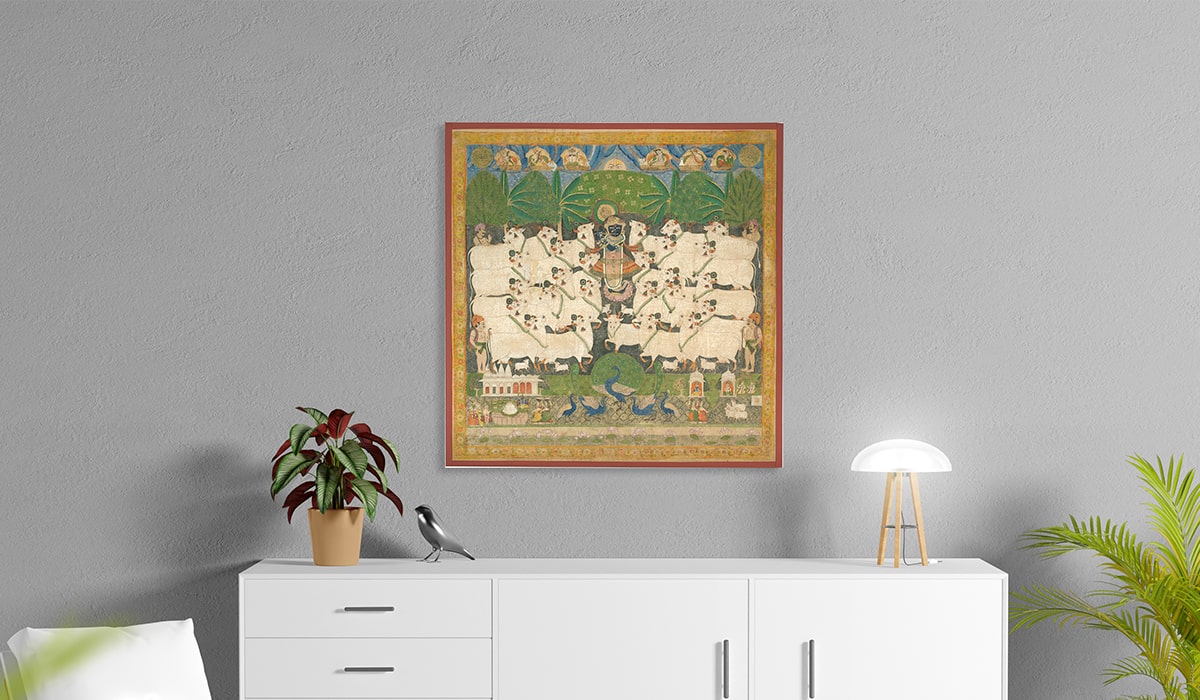
It is the festival in autumn and marks the coming of age for Sri Krishna on earth. Painting pichwai art often depict this occasion with many cows ornamented with handprints, peacocks, plumes, and bells.
3. Rass Lila
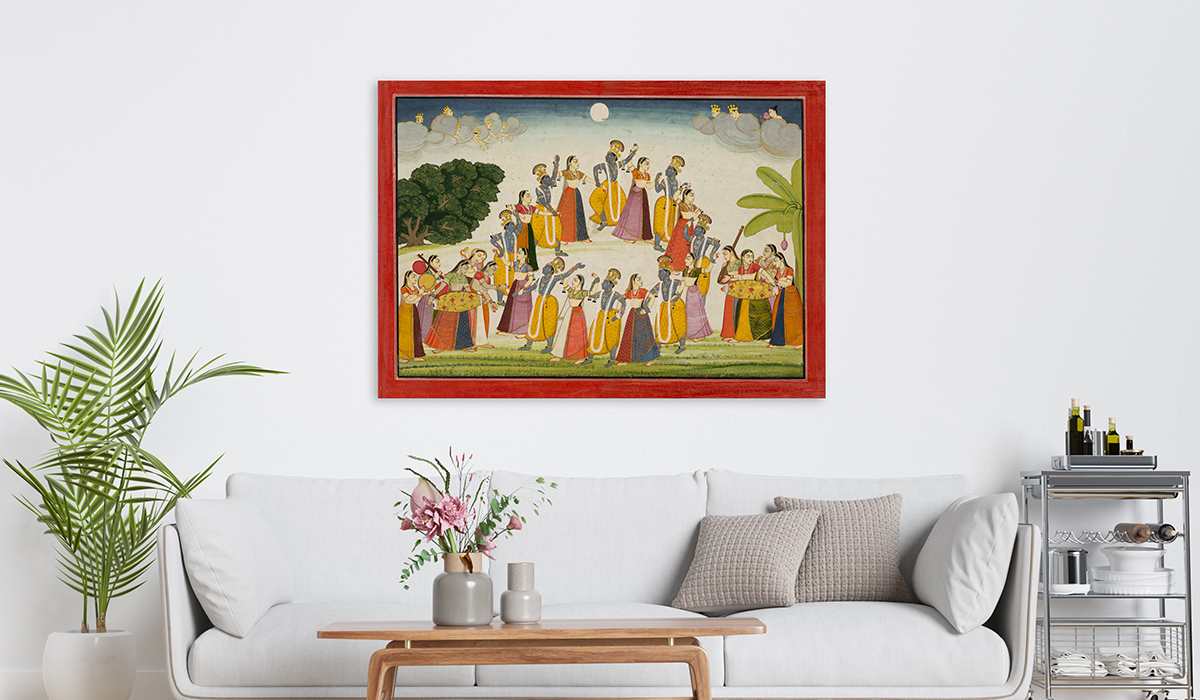
In the Pichwai art form of Rass Lila, adolescent Krishna dances with his maidens known as Gopis in the Vraj forests on a full moon night. Krishna takes several forms to give his attention to each of the Gopis, the paintings depict.
4. Daan Lila
As drawn in paintings, Krishna demanded milk and butter from the gopis to safely go home. Hence the Daan Lila depicts the gopis sharing their milk with Krishna.
Defining characteristics of Pichwai Artworks
The most common pichwai Krishna painting has huge eyes, a pointed nose, and a substantial physique. This fabric painting needs a starched cloth that takes 2-3 days to prepare and nearly a week to complete.
It takes a lot of time to learn pichwai painting. Pichwai painting is famous among people all around the world. from Uttar Pradesh and Rajasthan. Devotees and art connoisseurs like seeing these hanging inside temples, purchasing them, and displaying them on their walls.
The Pichwai art is an integral part of Indian culture and especially significant for Hinduism. Pichwai painting of Rajasthan has a tremendous demand overall in the world.
Pichwai Decoration Ideas
WallCurry offers creative ways to integrate Pichwai art into your home decor, transforming your living space into a sanctuary of divine aesthetics.
Pichwai decor and art, rooted in Nathdwara’s rich cultural tapestry, brings forth a visual symphony of colors, symbolism, and spiritual energy
Wall Art with a Pichwai Tapestry:
Hang some beautiful Pichwai tapestries as accent wall decor to liven up your home. Those narrating stories of Lord Krishna should be big and complex. An eye-catching display idea could be to build a gallery wall and hang up a number of Pichwai tapestries.
Pichwai Artwork for Walls:
Wall murals based on Pichwai can turn any plain wall into a showpiece. For an enduring and captivating experience, pick a scene that shows Lord Krishna’s adventures. Make the mural the showpiece; it will subtly alter the mood of the whole room.
Pichwai Cushion Covers
Put some Pichwai style into your seating arrangements by covering your cushions with covers adorned with Pichwai style. To make your sofas and chairs more traditional, mix and match different pichwai painting designs and colors. Adding some Pichwai art to your home has never been more accessible or more affordable than with these covers.
Dynamic Rangoli Inspired by Pichwai:
Create a Pichwai-inspired rangoli at your entrance for special occasions. Use vibrant colors to depict traditional motifs and symbols, adding a festive touch to your home. This ephemeral but lovely work of art will infuse your home with joy and good vibes.
Bedding with a Pichwai motif:
Embrace Pichwai art’s beauty with throw blankets featuring its elaborate patterns. Spreading them out over your sofa or bed will make your home feel cozier and more authentic.
Toran Pichwai Door:
Elegantly display a Pichwai door toran at your entrance to greet guests. Pick one with colorful, auspicious symbols to make an excellent first impression.
Pieces of Furniture with a Pichwai Twist:
The furniture should have Pichwai patterns. Think about accent tables or cabinet panels adorned with hand-painted Pichwai-inspired designs. These accents combine form and function in a beautiful way.
Ceramics Influenced by Pichwai:
Ceramics adorned with Pichwai motifs will take your dining experience to the next level. Purchase bowls, plates, or even tea sets decorated with these elaborate patterns. In addition to being functional, they enhance the visual appeal of your home.
Pichwai Lights and Lanterns:
Hang lanterns and lamps inspired by Pichwai to spruce up your lighting. These items serve a practical purpose while also pleasing the eye with their intricate patterns that reflect light and create a calming ambiance.
Pichwai Gallery
Make room in your house for a Pichwai art gallery. Arrange the more miniature Pichwai paintings in a harmonious way and frame them. This little gallery serves as an eye-catcher and provides a close-up view of the details.
Conclusion
Pichwai paintings can truly transform your room. Not only do they bring some serene, divine energy to your home- but they also add a distinctly ethnic touch to it. Buy Pichwai Paintings from Wall Curry collection of wallpapers and wall art if you are looking for some Pichwai paintings online or some other styles of Lord Radha Krishna paintings.
FAQ About Pichwai Paintings
Pichwai paintings are an integral part of Indian culture. For the Viashnavite sect Pushtamarg, they hold a special significance. These textile paintings show festivals like Diwali, Janmashtami, Holi, Sharad Purnima, Raas Leela, and Anakoot. Pichwai art is about the Srinathji form of Lord Krishna, and often depict him with his favorite things in the beautiful paintings. Pichwai paintings remain in tremendous demand among both devotees and art enthusiasts worldwide.
Beginner easy Pichwai painting contains a series of paintings on cloth using natural colors and vegetable dyes. Artists use a natural brush made from animal hair and cotton threads. It is a time-consuming process that often lasts for weeks- and the artists have to pay much attention to detail.
The artists stretch a stiffly-starched cotton cloth on a frame, and then apply the paint to it. In modern Pichwai paintings, artists often use block painting methods and apply adhesive colors and crystals.
Pichwai paintings depict the life of Lord Krishna and his festivals such as Janmashtami, Sharad Purnima, Raas Leela, and Diwali, among others.
The defining characteristic of Pichwai art is the distinct style for portraying human figures. They have pointed noses, big eyes, and a substantial physique. Lord Krishna occupies the center in most paintings, while the other motifs radiate around him.
The amount of time spent making Pichwai paintings gives us an idea about how hard this work is. To make the painting, it takes a few days to several months. A well-experienced person can complete the art within one week.
The stiffly starched cloth the artists paint usually takes two to three days to prepare. The preparation of mineral and vegetable dyes is also a time-consuming process. Then, painting and drying can take several weeks.
Pichwai was originally painted on cotton fabric that was starched by hand, then sketched on by the artisans, the results were beautiful and elaborate decorative images which then were ready for painting with organic colors, painted with natural brushes and painted with organic paint.
Pichwai painting is like a magical dance where there are special rules for how it looks and what it shows. Artists follow age-old methods, making sure each brushstroke is perfect. The rules say that we have to focus on Lord Krishna and use themes that are all about him.
We also need to include symbols and stories from this culture. Creating art is like embarking on a careful and thoughtful adventure, where we honor the rich heritage of artistic practices and weave together stories that touch our souls.
Pichwai is a really unique religious painting that comes from a place called Nathdwara in Rajasthan. Krishna pichwai painting is all about the little details, bright and lively colors, and telling stories about Lord Krishna’s extraordinary adventures and miracles.
The Pichwai style is like a beautiful party for your eyes, where devotion takes center stage. It’s all about preserving our cultural heritage and telling spiritual stories through stunning visuals.
Pichwai paintings are famous for their beautiful and lively colors, which are made using natural pigments. The spectrum is like a magical rainbow with vibrant blues, lush greens, rich reds, and dazzling yellows. Colors are more than just pretty to look at. They actually have special meanings and help tell the story of Lord Krishna’s divine presence in an exciting way.
Pichwai is incredibly famous for its beautiful artistry, deep cultural significance, and profound spiritual meaning. These beautiful paintings tell stories through pictures, showing the magical adventures of Lord Krishna. Pichwai is not just about art; it’s about something much more profound and meaningful. It’s like a special bond that connects people from all over the world.
Pichwai painting is a beautiful art form that originated in the vibrant state of Rajasthan, specifically in the charming town of Nathdwara. Rajasthan is famous for its rich cultural heritage, and it’s home to talented Pichwai artists who are dedicated to keeping this traditional art alive and spreading its beauty. Pichwai is a beautiful art form that vividly showcases the artistic heritage of our state.
Pichwai is not just any ordinary folk art; it’s a special kind of art that is deeply rooted in tradition and religion. Pichwai is a beautiful art form that has deep roots in the Pushtimarg sect. It is highly cherished and plays a significant role in the cultural traditions of Rajasthan. This artwork is exceptional because it has lots of little details and a specific theme that makes it different from regular folk art. It’s a one-of-a-kind way for people to show their love and preserve their cultural traditions.
Please Visit WallCurry for the most exclusive pichwai wallpapers!
 +919990299289
+919990299289 info@wallcurry.com
info@wallcurry.com


